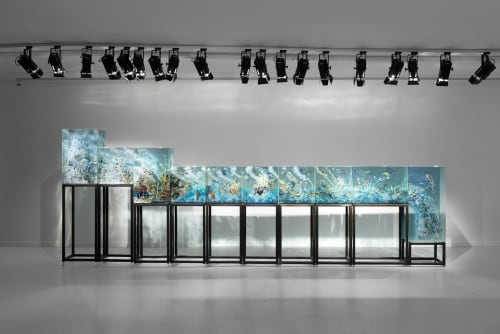Dustin Yellin: 10 Parts
GRIMM is pleased to present its first exhibition with Dustin Yellin, on the occasion of the 5th Amsterdam Art Weekend. In 10 Parts Yellin will debut a twenty-foot long modular glass landscape across ten panels. Also on view will be an extensive collection of smaller collages, six single module landscapes and both a figure and study from Yellin’s landmark series of Psychogeographies.
Dustin Yellin’s artworks can either be read as three- dimensional collages or two dimensional sculptures. They are made from thousands of intricate cutouts from magazines, books, encyclopedias and found imagery. With an unfailing sense for content and composition, Yellin paints these fragments together between many layers of glass. Being both transparent and opaque, bodily and cerebral, these objects offer us a window into an endless array of times and places. Yellin’s artworks serve as catalogues of a collective consciousness, frozen in glass and time.
10 Parts, the central piece of this exhibition, is a twenty- foot long landscape stretching across ten collage modules. It develops from icy peaks into a cascading seascape with countless figures and animals, eventually falling off the edge of the earth. 10 Parts offers a nightmarish vision of the future of humanity falling into the abyss —a reference to the pre-Socratic Flat Earth theory. Following Hiero- nymus Bosch as an example, Yellin fuses elements from our everyday experience with his imagination to form hallucinatory scenes. But in this case, the end of times is precedented by global warming and corporate greed. Treating image as artifact, Yellin is constructing
a spontaneous archive, mapped out by the DNA of circulated print media.
Dustin Yellin’s work can be seen in a broader historical context that began when George Braque and Pablo Picasso first started using newspaper print and found materials in their (Synthetic) Cubist paintings. Being central to
the Dada movement, artists like Hannah Höch and Kurt Schwitters further developed the collage technique, later followed by Surrealists such as André Breton, Joan Miro and Pierre Reverdy. But most significant to Yellin’s work is American artist Joseph Cornell and his shadow boxes, in which he created personal recollections and imagina- tive worlds. Dustin Yellin is taking the next step, using both the most delicate of materials, snippets of paper, and the heaviest of them, large glass panes. Weighing thousands of pounds his sculptures exist on the forefront of what is technically possible, while still requiring a careful human hand, patiently composing each scene.
Dustin Yellin is widely known for his Psychogeographies, an ongoing project, now five years in the making and currently counting over ninety sculptures. They function holistically as a group and are akin to Qin Shi Huang’s Teracotta Army. The lifesize scale of the sculptures creates a similar body encounter for the viewer. Living in a visual culture and technological age, we are being subjected to a continuous stream of images, ideas and ideals, that becomes part of our bodies and minds. When staring into the many layers of Yellin’s collaged figures, one can see deeply into the tissue that makes up our modern human experience. The particular Psychogeographies exhibited in 10 Parts present the human figure as landscape.
The largest objet d’art that Dustin Yellin has created so far is Pioneer Works, a multidisciplinary cultural centre in New York. Measuring 50,000 ft, this former warehouse is located in Red Hook, Brooklyn and houses an art gallery, music studio, radio station, science lab, school and garden. Since its founding in 2012, Pioneer Works aims to offer a transparent and collaborative environment in which inter- national artists, musicians, scientists, and educators push to shift the paradigm of cultural production and dissemination.






